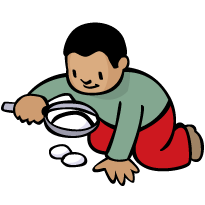Boston Children's Museum
308 Congress Street, Boston, MA 02210
617-426-6500
© Boston Children’s Museum 2025
Website Design by JackrabbitSpring is a time of rebirth and renewal—and eggs! Many animals lay and incubate eggs in the spring, and in some cultures spring is a time in which kids paint, hide and eat lots of eggs. This makes it a great time to not only take a close look at eggs, but also to experiment with some of the things we can do with them. This activity is part of the Incredible Egg series of activities, which are designed to be done during the Spring—start your students off with this and other “egg science” activities, then move on to egg art, and finally take the Egg Drop Challenge!
See the instructions for The Incredible Egg for preparations regarding all of the activities in this series.
For this activity, you will need to gather eggs ahead of time or ask parents to bring in any old eggs they have (and make sure you get the expiration date from the carton so you know which eggs are which). For this reason, you may want to prepare for this activity several weeks in advance, to give some of the eggs time to age.
Make sure to try out all of the other Incredible Egg activities:
Egg Science Activities:
Egg Art Activities:
Culminating Activity:

Ask your students how many of them eat eggs. Sometimes eggs sit in our refrigerator for a long time. Do eggs spoil? If so, how can we tell if they are old or fresh, without opening them up? Some students may say “look at the date on the egg carton”. This is, of course, excellent advice. But what if you took your eggs out of the carton?
Discover how to tell how old an egg is without having to crack it open!
After they have brainstormed and experimented for a few minutes, bring your students together to talk about what they tried. Did any techniques work? Why do they think these techniques will give accurate results?
If they have not discovered this method, show your students this way of determining the age of an egg:
Since eggs are porous (some air can get into them), “air cells” grow in them as they age. The older an egg is, the larger its “air cell”. You can open the eggs up after this activity and inspect the shells to prove this point.